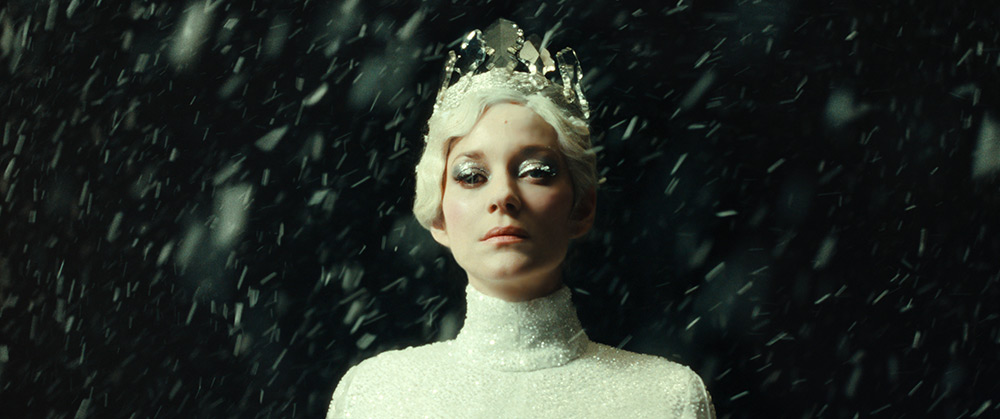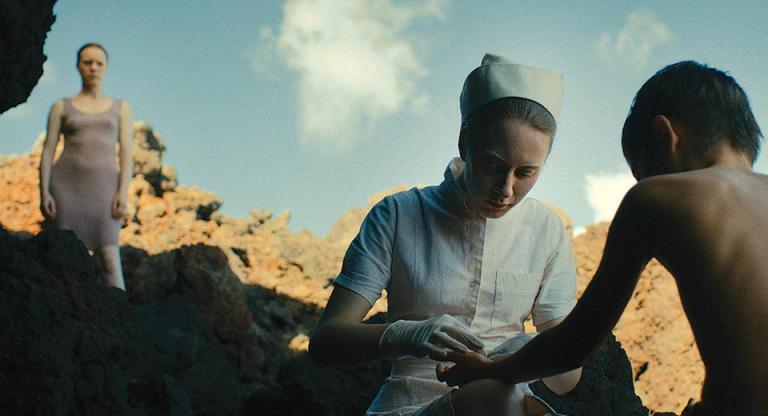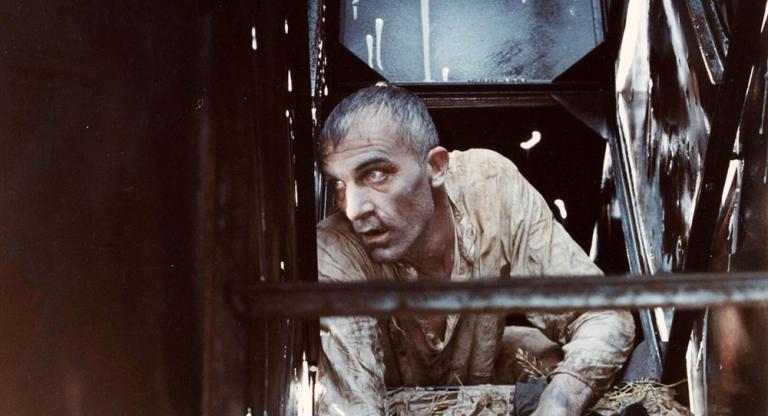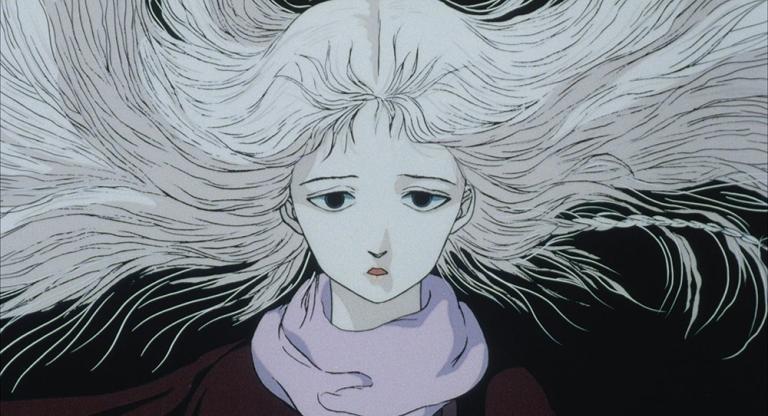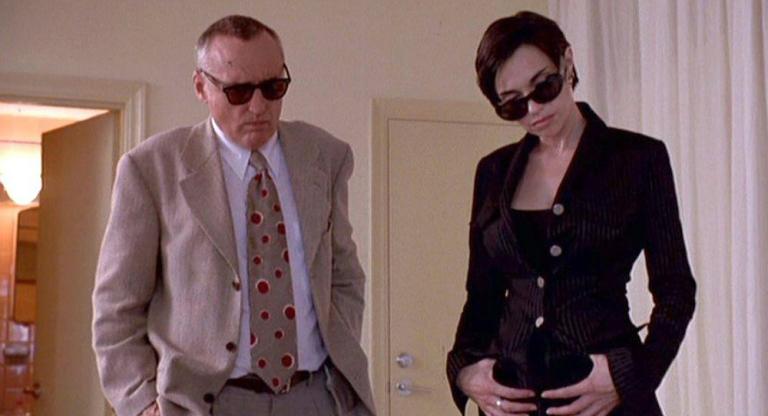For nearly 30 years, the French filmmaker Lucile Hadžihalilović has been spinning hypnagogic fantasies of children—timid preadolescents mostly—coming up against fraught, secluded surroundings. An all-girls boarding school where students arrive in coffins in Innocence (2004); a remote island populated only by women and their young sons in Evolution (2015); a cloistered, postwar apartment where a man performs a bizarre ritual with a 10-year-old shut-in in Earwig (2021). One might call Hadžihalilović's latest, The Ice Tower (2025), her most straightforward work, but this should be taken with the coarsest grain of salt.
Set in the 1970s, The Ice Tower sees 15-year-old Jeanne (Clara Pacini) flee her orphanage in the Alps and unwittingly stumble onto a film set adapting Hans Christian Andersen’s fairytale “The Snow Queen.” Hiding in the bowels of the studio, she becomes fixated on Cristina (Marion Cotillard), the mysterious prima donna in the starring role whose tyrannical methods rope Jeanne into posing as an extra.
I had the pleasure of speaking to Hadžihalilović about psychotic fairytales, finding and following mood, and the sound of cold.
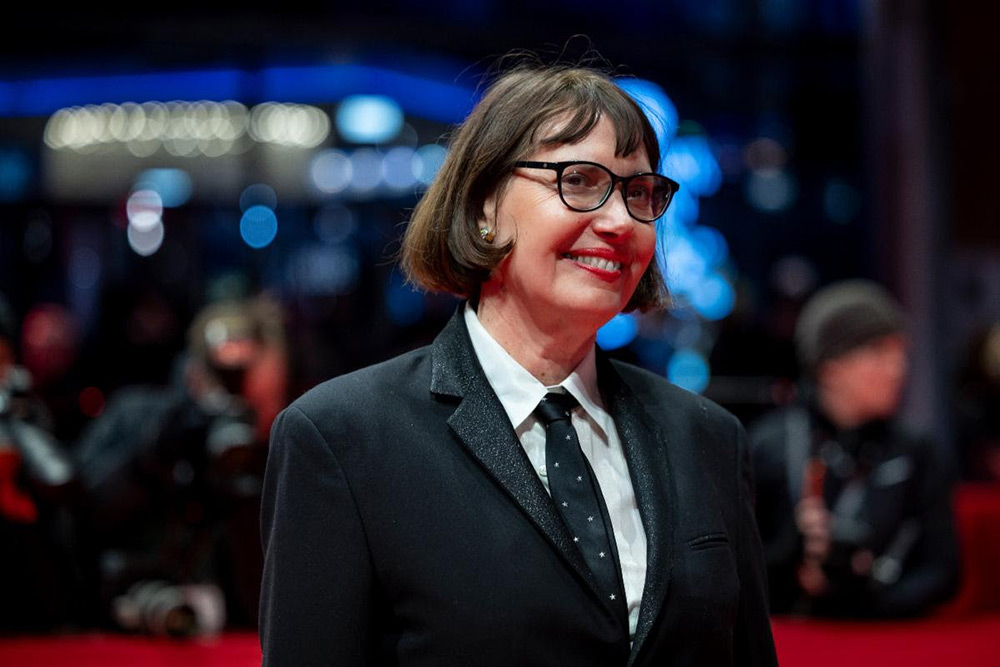
Saffron Maeve: In your films, coming of age is a social and at times physical mutation for the child characters, but in ways that draw out a kind of violence in the surrounding adults. What compels you to these narratives of orphaned, literally or spiritually, children in danger?
Lucile Hadžihalilović: I don’t actually know why they’re orphans all the time. I guess it’s because if they had parents, I’d imagine they would be protected. It’s a way to underline their fragility or isolation, or maybe it’s a feeling I had myself as a child, even if I felt protected by my parents. In this film, the Snow Queen is a figure I have in my other films, though not as obviously—this kind of cold mother, or the beautiful, distant woman who is also a figure of death. I was interested in confronting and digging around that, less about the social context and more about the psychological.
SM: All of your works inhabit a kind of mature, psychoanalytic fairytale structure, and this one explicitly. Were there specific fairytales you were drawn to as a child?
LH: Probably another tale by Andersen, like “The Little Mermaid,” which I found so cruel and masochistic. The idea of cutting half of your body and having this transformation that, in fact, is for nothing. That’s a story that many children know, but it had a very strong impact on me. Somehow, “The Snow Queen” seems a more optimistic story because the boy and girl are reunited at the end and manage to be free.
SM: Early in the film, we see Jeanne shine a flashlight over a poster for The Red Shoes [1948], another Hans Christian Andersen adaptation that seems to foretell the possession and self-annihilation Jeanne undergoes. What is your relationship to that film?
LH: I love Powell and Pressburger’s films, and the ballet within the film of The Red Shoes—the wonderful artificiality and that enchanting and sometimes scary world that could be better and more interesting than real life. I really like the idea of being possessed by something that is stronger than your will, so while I didn’t think directly of The Red Shoes when building this story, it was very much in myself. So was Black Narcissus [1947], which was another visual reference for us.
SM: How did you differentiate the two films—your own and the one that the characters are making—formally? Were they shot on different cameras?
LH: The difference is quite subtle because I wanted continuity. But we thought that they would have shot the film within the film on an anamorphic lens, so we did the same with a sort of fake CinemaScope. The other main thing was the lighting because it’s in a studio on a set, so there’s the idea that the actors should be lit as if it were the ‘40s. I had worked with Jonathan [Ricquebourg] on my previous film, Earwig, so we knew the direction early, and did a few tests to see the texture that could be created with the lighting, fake snow, and the focus on the [matte] painting.
SM: The Ice Tower also ends with these beautiful abstractions of rushing water, much like Innocence’s opening and closing scenes. What keeps drawing you back to images of water?
LH: I’m compelled toward these images and I find water a very cinematic element. In this case, I thought it was quite obvious because there is snow and ice, and this icy water which doesn’t “move.” Then, at the end, there is a sort of freedom where the glacier and the mountains could melt and there would be a river and a waterfall eventually. I thought it was a logical way of showing movement, liberation, and life. I didn’t realize how much it was like Innocence.
SM: They work to a similar effect, like release but also cyclicity.
LH: Because it’s seen inside the crystal in The Ice Tower. It’s like she’s in the crystal, maybe forever, but there is nevertheless free water flowing within it.
SM: Your visual style is often likened to fine art. Did you have works of art in mind when planning out your compositions?
LH: Not as much in The Ice Tower, but for “The Snow Queen,” I had a few film references for the visuals. One was A Midsummer Night’s Dream from the ‘30s because I wanted to have that kind of set and costuming, and the other was Black Narcissus for the mountain scene. For scenes of the city I wanted arcades, possibly because of [Giorgio de] Chirico, who is a painter I love, or Dario Argento—these empty streets at night with very structural elements of fascist architecture. Again, with Jonathan, we’ve looked at many paintings and photos together, so it’s come back unconsciously.
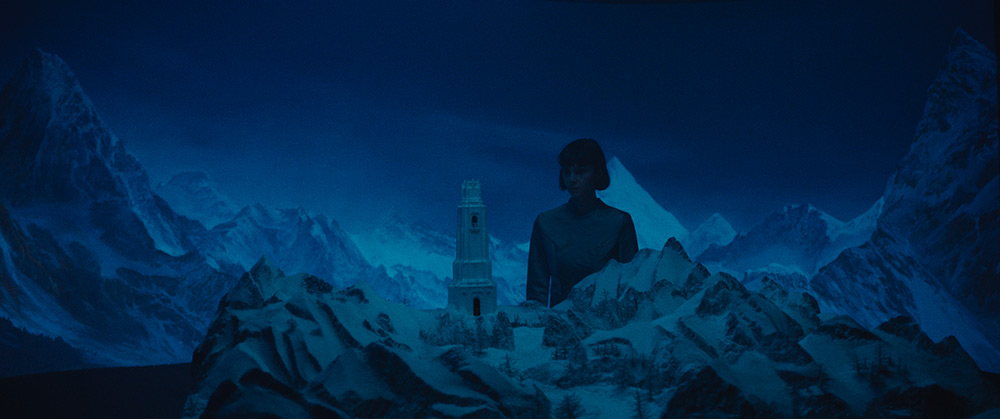
SM: Had you already been plotting The Ice Tower when you made Earwig?
LH: Yes, I wrote the script when we were trying to get the money for Earwig, maybe five or six years ago. I stopped developing it to work on Earwig, which was a good thing, but I had the first draft. I wanted something a bit more simple or, let’s say, obvious, but there was already the element of the ice and the reflection of the crystals that came from Earwig and became like a continuation of what we had made.
SM: How has your working relationship with Marion Cotillard shifted from when you last directed her in Innocence? Have your approaches or instincts as a director changed?
LH: I thought, at first, that she maybe would not accept doing a film with me because when we made Innocence, she was not yet such a star and didn’t have that kind of career. I didn’t want to imagine that Marion would be the actress while I was writing the script—usually, when I’m writing, it’s difficult to think about an actor. I had more older references for Cristina, like Marlene Dietrich or Greta Garbo. Then, by chance, I met her at a screening and she was very friendly and told me about how happy she was working on Innocence a long time ago. So I asked her about this one and that’s how it happened.
I wondered, because she’s playing a sort-of troubled diva, whether Marion would be in character as Cristina all the time, but that was not the case. Apart from the more superficial aspect of her fame, which was maybe frightening at first, everything was very natural and simple, like it was on Innocence. But because she’s such an experienced actress now, she’s become so technical. You could tell her to slow down by five percent and she would.
SM: You and Gaspar Noé have had your fingerprints all over each other’s work since the beginning of your careers: your production company [Les Cinémas de la Zone], your role editing his films, him shooting La Bouche de Jean-Pierre [1996]… Can you say more about casting him in the role of the director in The Ice Tower?
LH: At first, I hadn’t thought of him for the role because that director is so unlike him. I thought I had two options, either casting an actor or a director, and if it was a director, it should have been someone who could have made “The Snow Queen,” like Michael Powell or Mario Bava. For a while, I thought Guillermo del Toro could play it. But Gaspar then seemed to be the obvious choice because he has a sort-of Italian type of physique and face, and because we shot a bit of the film in Italy. We also thought it would be easy during the scenes with the props and fake snow around Marion to have an ally on set that would not pull too much attention and could manage by himself.
SM: It’s interesting you mention Powell and Bava, who both brought a kind of constructed artifice to their sets. What was your own process of designing the set of “The Snow Queen”?
LH: It was exciting to build a set for the first time. I love shooting on real locations because you get inspired by the place as you go, and maybe because my films are all in these imaginary worlds I need some reality to counterbalance them. We invented the sets from scratch, which was a challenge. I was a bit scared that they wouldn’t have any magic. Little by little, with the painting and the lighting, it worked. In the city scenes, we also created the ice rink.
SM: That rink is so strange and beautiful. It looks like a boxing ring.
LH: That was also a bit frightening because we thought it could end up looking like nothing. Julia Irribarria, who I worked with on my previous film, did the set design and was very inspired. She had to be to create all of that.
SM: You’ve adapted works by Frank Wedekind, Brian Catling, and now Hans Christian Andersen. How have these works come to you?
LH: In the case of Innocence, I had begun to work on a project that would later become Evolution, and was having a difficult time building that story. I thought if I could find a book or novel, it would be easier for me, and someone gave me Wedekind’s story [Mine-Haha, or On the Bodily Education of Young Girls]. I was fascinated by this feminine world and the emotions of these girls, then I totally betrayed the story. I didn’t think about what he was trying to say with the story, and instead projected myself into that place and invented different characters.
In the case of Earwig, it came through Geoff Cox, my co-writer, who was a friend of Brian Catling. Brian told him about a dream he had that he wanted to turn into a story, about a girl without teeth. Geoff thought that story was for me, even if it hadn’t been written yet. When it was written, it was such a rich novel and there were so many elements I didn’t understand or relate to. I changed it quite a lot because Brian very generously said “if you betray me, that’s better.”
I’m attracted by moods, emotions, and situations more than stories. With “The Snow Queen,” I was fascinated by the fact that the girl moved through so many environments, so I merged her and the boy character into one and she became half-boy, half-girl in a way. I kept some of the mood and the poetry, but I like working freely, taking things and twisting them.
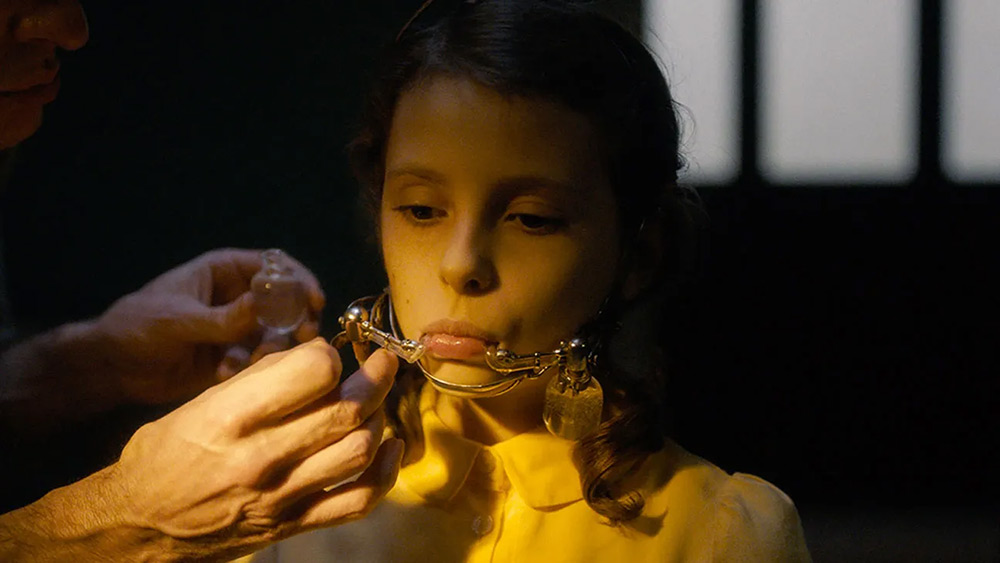
SM: What about matching sound design or music to the moods? How did you decide how some of the more abstract moments in The Ice Tower were going to sound?
LH: I wanted the film to have some music—not composed but musical elements. So the Olivier Messiaen piece that plays at the beginning [Fête des belles eaux - L’eau à son maximum de hauteur] is repeated like a theme because I thought it had a trance-like effect. Ken Yasumoto, the sound editor, and I worked by removing many elements and sounds, which created a bit of abstraction. We wanted to convey the feeling of the snow and wind—what does the cold sound like? We worked a lot with reverberation or echoes to fill the space, and even worked on the Snow Queen’s voice to give a special texture to the character of Cristina.
SM: It’s interesting to hear you speak about defaulting to mood rather than narrative. In an interview a few years ago, you noted that you “try not to analyze” your films as you’re making them, and that you only get a sense of what “crime” you’ve committed once they reach an audience. Do you feel that audiences tend to misinterpret your aims as a filmmaker?
LH: The misinterpretation was really with Innocence at the beginning of my career, especially in France. I remember the first article that came out saying this wasn’t just shameful, but pedophilic, which was very much a misunderstanding. With my other films, it’s more about people not wanting to go with it.
I’m always surprised that people say there’s no story, for instance. The plots are simple, but that doesn’t mean there isn’t a story. The other problem I have with audiences is pacing, which is happening more and more. I totally accept that there are problems or mistakes within the films, but people’s brains are so eaten by their phones now.
SM: The Ice Tower also literalizes the experience of stumbling onto a film set as a young person and then determining your relationship to the images being created. Thinking back to your time at La Fémis, making early films like La première mort de Nono, did you experience a similar disorientation or obsession?
LH: Absolutely! Before film school, I had no idea what it was like to be on set or to deal with the realities of it. I felt so attracted to cinema and what I was seeing onscreen—it was like a familiar place—but then sets were totally something else. It was very difficult for me to see myself as a filmmaker with the type of characters I had. But, you learn, little by little. In The Ice Tower, I wanted to show more of the artificial world that this girl enters and how it feels just as real as the rest of the world.
SM: You’re discovering your relationship to cinema and your own impulses as a worker corralling a set at the same time.
LH: And you have no idea what you’re doing or building, which is fine. It’s good not to know before you do it and then, once it’s done, you understand something or the audience tells you what it is. You have to realize that you’re building something against or beyond your will.
The Ice Tower runs October 3-9 at IFC. Director Lucile Hadžihalilovic will be in attendance for Q&As this weekend.
